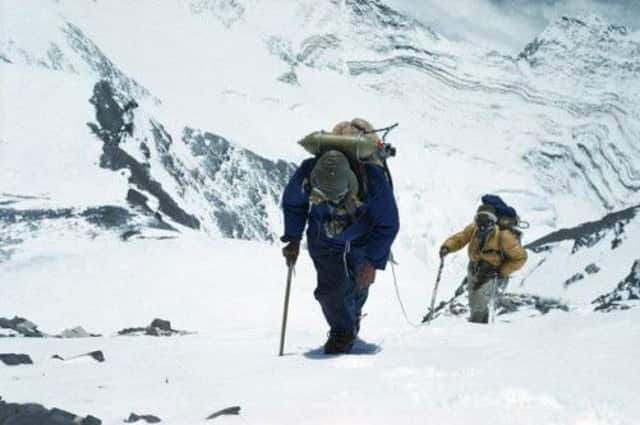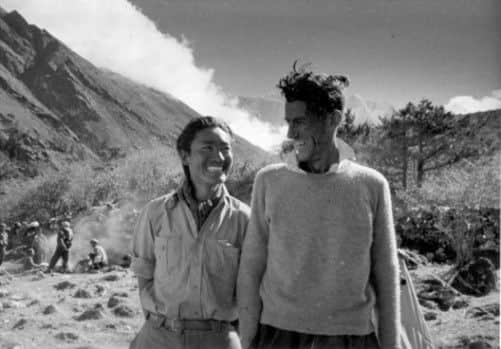Hillary and Tenzing’s Everest summit agreement


At just before 6am, 60 years ago today, two men watched as the sun rose over the roof of the world. Edmund Hillary, the 33-year-old son of a New Zealand beekeeper and Tenzing Norgay, the 39-year-old son of a Nepalese yak herder, were just above the South Coll on Mount Everest, 8,504m (27,900ft) above sea-level and dining on a breakfast of tinned apricots, sardines and hot tea in temperatures of -17C), which, with the wind-chill factor, was reduced to -50C. Today was their chance to step into the history books as the first men to conquer the highest mountain in the world. They were not the first choice. A day or so previously, Tom Bourdillon and Charles Evans had been chosen by Colonel John Hunt, leader of the 1953 British mountaineering team, to claim the summit for the Commonwealth but they had been beaten back with just 300 feet to go by a combination of exhaustion and malfunctioning oxygen cylinders.
Of the two men now clinging to the face of the mountain, only one knew how Bourdillon and Hunt must have felt. For the previous year Tenzing Norgay had got within 750 feet of the summit on an expedition led the Swiss mountaineer Raymond Lambert, who had wept on his shoulder at their defeat before taking off his red scarf and wrapping it around his companion’s neck. Norgay wore the scarf today as a good-luck charm.
Advertisement
Hide AdAdvertisement
Hide AdAfter finishing their breakfast, the two men pushed hard for the summit and, four and a half hours later, at 11.30am they stood together on the peak, and gazed, as the first men in history at the view laid out below. When word finally reached base camp, a reporter with the Times who was with the expedition despatched a runner with a coded message to conceal the paper’s scoop which read: “Snow conditions bad. Stop. Advanced base abandoned yesterday. Stop. Awaiting improvements. Stop.” Edmund Hillary’s statement to his colleague, George Lowe, was more succinct: “Well, George, we knocked the bastard off.”


Yet who was the first one to set foot on the summit? To judge by a banner erected shortly after in Kathmandu, in which a semi-conscious Hillary is dragged to the summit by Tenzing, it would appear to have been a matter of some debate and no small amount of international pride. Meanwhile, back in Britain, it was unthinkable that news could break – on Coronation Day – that Hillary had climbed Everest, but had been pipped to the post by a local.
And so for decades rumours swirled around that it was not Hillary whose boot was the first to crunch down on the summit of Everest but that of Norgay. Indeed, two of Norgay’s sons have said that their father confided in them that he had reached the top first, not Hillary. The environment in which such rumours multiplied was created by the two climbers themselves, who insisted that they had reached the summit together and that it was immaterial who had led the way.
“When we came out toward Kathmandu, there was a very strong political feeling, particularly among the Indian and Nepalese press, who very much wanted to be assured that Tenzing was first,” Sir Edmund would recall later. “That would indicate that Nepalese and Indian climbers were at least as good as foreign climbers.”
For over a century, ever since 1852 when mathematical calculations had confirmed that what JW Armstrong had referred to five years previously as “Peak B” (not even “peak A”) in his survey of India was, in fact, the tallest peak in the world, mountaineers had dreamed about reaching the summit, and none of them dreamed about being in second place.
As a boy, in the isolated Khumba region of Nepal, Norgay had shared that dream of one day climbing to the summit of what he referred to as “my mountain”, and which had loomed so high above the pastures where he had once herded goats. In many ways, he had come the closest as, having earned a fine reputation as a skilled sherpa and climber, he had participated in five previous attempts.
So what did happen on that mountain peak 60 years ago today? A new book, published to coincide with the 60th anniversary, Everest 1953: The Epic Story of the First Ascent by Mick Conefrey explains how the politics of the time led to a period of confusion. According to a memo found in the archives of the Royal Geographical Society, Colonel James Hunt – who led the expedition – and Christopher Summerhayes – the British ambassador to Nepal – doctored the official account in order to conceal who got to the peak first and made the decision to share the credit between both climbers in a bid to defuse the anti-colonial feelings that had built in both India and Nepal since India’s independence, six years earlier. The memo stated that Hunt insisted on the preparation of a revised version “due to a desire not to cause offence to Nepalese nationalists and smooth over the dispute as to who got there first”. So, in accordance with his wishes, the statement released by the expedition in Kathmandu, had ambiguous wording which stated: “A few more whacks of the ice axe in the firm snow and we stood on the summit”.
However, the archives included the original account of the achievement by Hillary, a three-page memo in which he had written: “(I) stepped on top of Everest…I quickly brought up Tensing [sic] beside me”.
Advertisement
Hide AdAdvertisement
Hide AdFor over 30 years both men stuck to their gentleman’s agreement and refused to say who had reached the summit first as, in climbing terms, no-one could have reached the peak alone. It was only after his friend’s death in 1986 that Hillary felt able to speak freely, saying: “Finally, I just got a gutsful of it. I got tired of people saying Tenzing had got to the top first.”
In an interview with Scotland on Sunday for the 50th anniversary in 2003, Hillary explained what had happened: “We set off at 6.30am, first light, me in the lead, Tenzing behind on a tight rope. We never discussed who would be first up. It really did not matter to me, as the entire expedition was very much a team affair, but I suspect Tenzing was quite deferential to what he saw as the Sahib. So I got to the top first, with him just 10ft or so behind.
“I shook his hand in good old Anglo-Saxon style, but Tenzing was a bit more demonstrative and he gave me a huge hug, and we embraced for some minutes, just savouring the moment. We were only on the summit for 15 minutes or so, and I had my oxygen mask off and recall visually plotting a route up some nearby peaks while I was there looking down on the world.”
As Tenzing had recalled years earlier, it was the “great moment for which I had waited all my life”. There was “no more up.” He said: “I waved my arms in the air and then threw them around Hillary, and we thumped each other on the back until, even with the oxygen, we were almost breathless.”
Hillary explained the reason behind the decision not to focus on who reached the summit first: “We had cooked up the story that we got there in unison – after all, there was no-one there to dispute that. I felt it was no big deal, as I was just part of an overall team effort, and one of two, with Tenzing Norgay, to make it to the top. I did not see it as a deception or a distortion of history, and I still view it that way 50 years on. I have not seen myself as much of a hero, but Tenzing undoubtedly was.”
The experience of standing on the roof of the world meant that, for both men, the only way was down and both endured their share of hardship and pain. Hillary, who died in 2008, lost his wife and daughter in an air crash and Tenzing lost what had become a comfortable life when, in 1964, the Indian prime minister Nehru, who had promised to support him, died.
Yet Tenzing never lost his pride in his achievement and once joked: “If it is a shame to be the second man on Mount Everest, then I will have to live with this shame.”